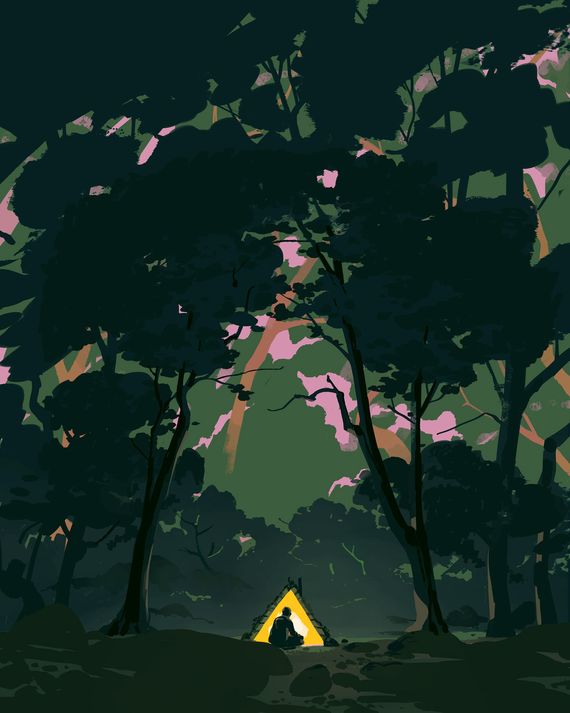
Illustration: Patrick Leger
This article was featured in One Great Story, New York’s reading recommendation newsletter. Sign up here to get it nightly.
In late February, a team from Leftfield Pictures, the production company that makes the History Channel’s Alone, convened over Zoom to view an early version of an episode from the show’s tenth season. The series, which premiered in 2015, is a competition reality show. Each season, ten contestants are dumped in the wilderness with limited supplies and must fend for themselves as long as they can. The last person standing wins $500,000. Almost all of the footage is taped by participants. Since the survivalists for the new season left the field, around 15 assistant producers had spent months logging the mountains of raw recordings. This was the first time the producers were seeing the edit.
In the episode, James “Wyatt” Black, a Canadian contractor who is a familiar archetype on the show — pure mountain man, all machismo — isn’t doing so hot. Several days into deployment, he has failed to secure food beyond berries. His body is not getting enough calories to maintain mass. Then, at the end of day five, there’s a successful fishing attempt. Overjoyed, Wyatt does a little dance for the camera. The footage progresses through the fish-preparation process: gutting, filleting, grilling. He makes a euphoric sound as he bites into flesh.
“Is that his first true bite?” asked Ryan Pender, an executive producer. The discussion hovered around how best to build up to this scene. “Is there anything to be gained by making him a villain?” asked another producer. “I mean, there are no villains in this, but he’s a guy who benefits from being humbled, right?” Jeffrey Rodriguez, the supervising producer, considered the suggestion: “There’s something to be said about how he approaches this as someone who’s like, I know what I’m doing, and I’m going to win this because I’ve done this my whole life.”
“Bravado,” said Pender. In the final version, the scene is largely intact.
The debate reflected a core aspect of Alone’s value system. The show is generous with its participants, who, thrust into the wilderness to see who can weather the conditions on their own the longest, are treated as individual heroes, each on their own journey. It’s hard to have villains on a show completely devoid of interpersonal conflict. At the same time, viewers watching the action unfold are playing their own version of the Alone game, judging the contestants’ actions against the decisions they would have made. There is always behavior worthy of criticism — often it’s overconfidence. The Leftfield team members weren’t there to witness the bite, but they could make sure it played with maximum resonance in the final cut.
Since its debut in 2015, Alone has carved out a loyal fan base, but viewership spiked in 2020 when select Alone seasons became available on streaming platforms like Hulu and Netflix. For people sheltering in place as COVID raged around them, there were obvious psychic links. The fragility of the human body is a subtext in every frame. By a season’s end, viewers are watching contestants try to delay physical and mental declines they have no chances of outrunning entirely. It’s an exercise in controlled dying.
Three years after Alone’s pandemic-era bump, a proper franchise is in the works. The History Channel has rolled out several spinoffs: The Beast, Frozen, and The Skills Challenge. An Australian version debuted in March and went on to become the most-watched series in the history of SBS, the country’s public broadcaster; a British version recently debuted. Both come after a Danish version introduced in 2017 in which, in a cross-cultural twist, there is no prize money. Up in the Scandinavian cold, the survivalists compete only for glory.
Reality television is usually a producer’s medium in which struggle and conflict are seeded during filming from the top down. The women of The Real Housewives are placed in situations where they’ll blow up at one another. Top Chef throws curveballs through the design of each elimination challenge. Love Is Blind is tightly controlled from the second the singles walk into the dating pods. But Alone radically commits to the promise of its name. There are no producers on set to instigate conflict or opposing personalities destined to be explosive. And yet the result is the most compelling reality competition on television.
Alone didn’t start out as a competition. Shortly after Naked and Afraid became a hit in 2013, the History Channel executives were exploring concepts for their own survival show when a pitch arrived from the Realscreen Summit, an annual conference for unscripted programming. The idea, called Survival 365, was for a longform docuseries that charged four people with filming themselves living off the grid in different parts of the world for up to a year.
“The pitch tape was cobbled together from footage of someone who had gone into the woods and filmed himself trying to quit smoking,” recalls Zachary Behr, the History Channel’s VP of programming. “It didn’t go that well for him.”
At the time, the History Channel was in the middle of a transition. Nancy Dubuc, who later had a stint as CEO of Vice, had recently taken over the chief role at parent company A+E Networks, and under her watch, the channel was broadening beyond dadcore history documentaries. It had found some success with what Behr calls “workplace docuseries” like Pawn Stars and Ice Road Truckers and had just broken into the competition format with Top Shot and Forged in Fire when the pitch for Survival 365 came in. It made sense to reimagine it as a competition, by then retitled Alone, though the channel preserved two aspects of the original idea: its vérité feel and the emphasis on self-documentation.
In the beginning, the show sought out potential candidates through focused outreach efforts; these days, it receives about 10,000 new applicants every season. Each candidate is vetted for their survival expertise and tends to have a background in bushcraft, big-game hunting, homesteading, or the military — in other words, they are the type of people who could subsist in the wilderness with only a selection of highly regulated items. The History Channel provides competitors with some standard safety equipment and clothing (everyone gets six pairs of wool socks, an insulated parka-style jacket, a toothbrush, two pairs of thermal underwear, and one personal photograph) as well as a limited amount of specialty gear to choose from. This is when the strategizing begins. Hunters choose to take bows (Alone prohibits guns). Handymen choose a folding saw to make lumber for shelters (tents are forbidden). Passive fishers choose paracord to weave gill nets (no professional rods or lures are allowed). But choices carry risk. A gill net may be essential or pointless — what if there are no fish in your stretch of river?
Much of the show’s appeal lies in its attunement to quotidian beauty and introspection. Each season opens with a flurry of footage as the survivalists enthusiastically explore their allotted territory, build shelters, set up traps, forage for berries, and hunt for meat. There’s tremendous pleasure in observing how the competitors cultivate their surroundings, heretofore pristine nature. A fan favorite from the third season, Callie North, handcrafted an entire makeshift sauna complete with a moss walkway. An Alaskan named Roland Welker spent weeks building a house out of rock. Colter Barnes, whose season took place on Chilko Lake, one of the largest bodies of water in remote British Columbia, used a tarp to construct a boat that became vital to his food strategy.
But as much as the show celebrates ingenuity, it is equally about the galaxy of ways a human can fail. As winter sets in, the contest settles into a grinding rhythm. Small accomplishments, like starting a fire or catching a single fish, become increasingly cathartic. Medical checks, a driving force for the show’s drama, happen more frequently. This is when Alone takes on a sheen of body horror. Competitors can voluntarily tap out of the game, but they can also be pulled from competition by producers for being frostbitten, dentally compromised, constipated, food-poisoned, or simply starving to the point of potentially irreversible bodily damage. In the punishing cold, the beauty of the natural world gives way to a menace that feels closer to The Blair Witch Project with prize money.
Another alum of the Chilko Lake season, a man named Biko Wright, set off into the woods with hopes of fishing his way to half a million dollars. The prize would have been life-changing for Wright, a construction worker and musician whose partner back in Oregon was pregnant with twins. But two and a half months into his time in the wilderness, the lake is so frigid even the Chilko fish have fled to warmer, unreachable depths. Wright has been subsisting mostly on tree-bark soup he cooks beside a ramshackle shelter built of trunks, branches, and a tarp. “I just feel so weak and lethargic,” he says, speaking into a camera, a dark fleece hood falling to just above his eyelashes. “My body feels like it’s falling apart.”
“I’m sorry, Erin,” he says, speaking directly to the mother of his children. “I gave it everything I got.” As he cries softly, now more than 90 pounds lighter than when he arrived in Canada, a line of text flashes across the screen: “Starvation can result in depression, hysteria, and a decline in concentration and comprehension.” A few scenes later, he taps out of the game. There was only one other person standing between him and half a million dollars.
Participating in Alone is obviously a big risk for contestants. But green-lighting it was also a big risk for the network. Its open-ended time frame meant that potential costs were variable. (In theory, finalists could last indefinitely, though so far no one has made it to four months. Ahead of the season-ten finale, the record stands at 100 days.) There was also no telling if a coherent narrative could be constructed from the self-recorded footage. What they got was what they got. Producers couldn’t go into the field to re-create moments to paper over gaps in emerging stories. Lucas Miller, who competed in Alone’s inaugural season, remembers feeling skeptical about whether the production was actually going to commit to the hands-off approach.
“It wasn’t until two weeks into the experience that I started to believe they weren’t gonna jump out in a bear suit,” he says.
It was Dirk Hoogstra, the History Channel’s former general manager, who introduced the idea of giving the $500,000 prize as a hook for the viewer — thus adding a Squid Game patina to the entire enterprise. “I think the prize is important to the audience. It adds a level of stakes,” says Behr. “Does it take away some of that purity? A little bit. But it’s a TV show, ultimately, and it has to be entertaining.” The money came as a surprise to the first class of survivalists, who had signed up without the incentive and were informed only days before setting out into the wilderness. (All participants are also given a stipend to compensate for lost wages in their normal life that starts the day they leave for the season’s location and ends once they return home.)
“Some were stoked; some were bummed,” Behr says. “It definitely colored the experience,” Miller adds. “You’re out there having these really powerful moments, but then there’s this cash bag always floating around in your mind.”
The first season, held on Vancouver Island, kicked off with relatively little infrastructure. Safety protocols expanded only after the series started shooting and producers began to understand the true scope of the undertaking. “I wasn’t brought in until the third day after launch,” says Lars Andrews, a veteran safety specialist who has worked on adventure-reality-television staples like Survivor and The Amazing Race. “There was lots of room for improvement — let’s put it that way. Everybody was flying blind in a way that was probably riskier than what it is today.” On the fourth day, a survivalist was charged by a bear, forcing him to hide in his makeshift encampment and call for extraction. It took hours for the safety team to reach his location, which required navigating dense brush; it had set out unsure of his precise location. The entire sequence was heavily featured in the third episode.
More robust safety policies have been introduced to the production since. Survivalists are now required to check in twice daily via a satellite device. Emergency-response teams are located no more than 45 minutes away, though in practice it’s a tough proximity to maintain. When a survivalist in the sixth season, Nathan Donnelly, was forced to tap out owing to a late-night shelter fire, a severe storm meant that the extraction team couldn’t reach him until morning. Although production determined he had enough resources to last the night, he was left exposed for hours in temperatures that went down to zero degrees Fahrenheit.
During a shoot, production base camp is typically staffed with a skeleton crew: safety teams plus one or two producers who monitor participant progress, observe the weather, capture B-roll, and log footage from the memory cards swiped during medical checks. These checks increase in frequency as time goes on — only conducted twice in the first 40 days, they eventually accelerate to every ten days. During the checks, which last from around ten to 15 minutes, the medical team assesses several factors: body-mass index, cognitive function, mental health, heart rate, and blood pressure, among others.
“We want to preserve their well-being as best we can while allowing them to go as deep as they possibly can,” says Andrews.
These visits are also when contestants are informed if they’ve won. As the season rolls on, the survivalists navigate the checks with trepidation and anticipation: This could be the end, whether in defeat or in victory. “It’s like a little bit of hope and then you dip down deeper,” says Britt Ahart, who competed in two seasons. “The day I tapped out was the day of my last check in … They showed up, they left, and I’m like, I can’t go back inside my shelter.” As with Wright in season eight, there had been only one person standing between Ahart and half a million dollars.
In the Zoom session, the Leftfield team members deliberated the best way to tackle editing a scene in which another survivalist, a carpenter from Georgia named Mikey Helton, has strayed too far from his trail. Navigating through thick brush, he monologues into his camera. “My whole body’s shaking,” he says in a flat voice, bottling a sense of simmering panic. “This trail looks so familiar, but that’s the thing — it’s not. I’ve never been here before.”
The editors wondered, What’s the right amount of danger to convey here? “I think we need to kind of get more into strategy rather than saying how bad it’s been,” said one. “Because we haven’t learned the fact that he’s starving at this point.” Pender interjected: “He’s not starving. He’s uncomfortable, and I think the folks at home will tell there’s a difference.”
Alone’s storytelling is a balancing act: a blend of action and introspection, of authentic character beats and sequences that expose viewers to the practical strategies of survival. “We’re often trying to find the journey that each character is going on mentally and emotionally,” says Kiran Malhotra, a former executive producer. “At every step, we’re asking, ‘What are we learning about this person?’”
Such a focus on character places heavy importance on casting. Quinn Fegan, Alone’s casting director, describes cohorts in terms of an ability mix. “We always want a good number of people who have taken down big game with a traditional bow in the past,” she says. “We also typically want some military being represented, and any time we have an amazing bushcrafter is great.”
Owing to the competition’s dangerous nature, candidates go through a substantial vetting process. They have to pass a practical-knowledge exam. (“What kind of wood is appropriate for a bow drill?” Answer: “Cedar, aspen, and yucca are workable options.” “Can you construct a makeshift bow drill?”) They need to show proficiency with a camera, for obvious reasons, which they’ll be further trained in during a boot camp right before they’re dropped in the wild. A psychologist is brought in to assess whether prospective participants have the necessary coping skills. Long on-camera interviews are used to identify each candidate’s motivations, unearthing early narrative threads that can drive the edit later on.
Alone tends to foreground people who don’t frequently appear on television — at least, not in a format that presents them on their own terms. Many participants come from working-class and rural communities. Some grew up in deep poverty. More than a few are on the fringes of society: homesteaders, back-to-the-land types, those who live off the grid and make a living teaching survival and primitive skills to others. Political ideology is never overtly expressed on the show, though, of course, viewers can make assumptions (and dive down survivalists’ social-media rabbit holes themselves). But Alone itself is a rich, complicated political object. One could read it as a fundamentally libertarian show, grounded in its celebration of self-reliance. But given how the competition ultimately ends in bodily decline, one could equally read it as an indirect critique of libertarianism: No person is an island.
There is often a tension in the way the prize gets talked about. Many survivalists downplay its importance. “It stops being a part of your daily consciousness once you’re out there,” says the sixth season’s winner, Jordan Jonas. “Your daily pressure is not to starve.” Contestants prefer to describe Alone as an unparalleled opportunity to test oneself, accessible only when divorced from the modern world. “One of the gifts of this show is that it took everybody who might be gifted in hunting or outdoor skills and gave them a path to challenge themselves,” says Miller, the first-season competitor. “It has changed my life forever for that reason.”
“I grieve not being able to live like that all the time,” says Woniya Thibeault, another season-six contestant. Alone tells a story of what happens when one separates from the industrialized world and is stripped down to the bare basics of the human condition. It is a rejection of modernity that stages wilderness survival in its purest form, where survivalists find freedom in a simulation.
Yet within the show, the participants’ behavior tends to be refracted through the lens of what money can bring to their lives. Helton, the Georgian carpenter who got lost, for example, has a wife and five kids, one of whom is on the autism spectrum. In moments of introspection, he often talks about how the money would help his child get the therapy he needs. “I feel bad for leaving him,” he explains to the camera. “For nine years, I’ve wanted to do this — to come out here and push myself to see just how far I can go before I break. But for the past three years, it’s been because I’m broke and I can’t afford the therapy that my son needs.” The sheer intensity on display often compels one to wonder, Would anyone really be here if it weren’t for the cash?
Alone is one of the History Channel’s largest shows. According to Nielsen, 20 million people watched the ninth season, which came out last summer. It has a growing list of celebrity admirers: Rachel Brosnahan and Ted Danson talked up the show during 2020’s virtual Emmys coverage; Gwyneth Paltrow, Kylie Jenner, Tom Hanks, and Joe Rogan have all publicly declared their fandom. Alone’s tenth season features just as many withering bodies and slipping minds as past seasons. Its penultimate episode ends with three competitors starving it out. The finale will air on August 17.
For Behr, the long-term challenge of Alone lies in finding ways to keep the show fresh while preserving its fundamental shape. So far, there has been an all-star “redemption” season involving returning competitors, a not-so-alone season during which survivalists competed in pairs, and a million-dollar season (the prize pot was doubled with the catch that it could be awarded only to contestants who had lasted 100 days — meaning there could be multiple winners or none at all).
“I think we’re on more of an Amazing Race path than a Survivor or even a Naked and Afraid path,” Behr says. “It has to go deeper, as opposed to going down a million different paths.”
Most of Alone’s seasons have taken place in Canada, a country rich with public land and a temperate climate that effectively scales up the stakes. There is interest in staging the show in Central America and Africa, though that would require grappling with a new set of challenges, like how different fauna introduce novel health risks. More than that, though, Behr sees depths uncharted in the show’s casting strategies. After Alone’s first season, which exclusively featured the kinds of white men you’d imagine browsing at Cabela’s, the talent pool has expanded to include more women and people of color. “Most of these survival shows are very male dominant,” says Thibeault, who also competed on Frozen, the Arctic-focused spinoff. “Even with Alone, Frozen was the first time they had equal numbers of men and women.”
Casting director Fegan says the show is starting to consciously consider competitors “for whom this stuff isn’t their entire life.” Given the difficulty of the competition, and how its appeal is rooted in the expertise on display, widening the pool of who can thrive in the wilderness may be easier said than done. The show has cultivated a reputation for being the “Olympics of Survival” among the survival-skills community, Behr says, referring to a relatively small, tight-knit, and geographically disparate circle that connects online and at occasional in-person meetups and has been historically wary of its portrayal on reality-television programs.
“There’s always a level of fabricated conflict, and you just know there’s some puppeteering happening behind the scenes,” says season-three and five alumnus Ahart. “Alone is the only survival show I thought had real legitimacy to it.”
That isn’t to say all competitors believe they are portrayed perfectly (or that, upon returning home, they have the emotional distance to watch their seasons at all). Various alumni, some of whom keep in touch through a Facebook group, have lamented how little of their footage ends up in the final cut — multiday fishing trips, deer stalking, maggot farming. Season-three competitor North doubts any TV series could really plumb the depths of the personal experience that is Alone. “For my journey, a lot of it was very hard for that to be conveyed through the television,” she says. “And that’s fine. It didn’t need to be for my own personal journey, even if a lot of people watching didn’t understand what my process was and why I chose to leave when I left.”
Upon returning home, some Alone competitors gleefully tweet along as the season airs, careful not to spoil their own fate on the show and promoting newly curated YouTube channels. Past winner Zachary Fowler now has more than a million subscribers, which he has parlayed into a full-blown social-media-influencing career; another champion, Clay Hayes, has more than 300,000. Others have launched GoFundMes to start a wilderness school or, in the case of Donnelly, the survivalist whose shelter burned down in season six, to simply build a house. The History Channel, it seems, is not immune to the effects of late-stage reality television, though Fegan claims approaching the game with a brand-first mentality is frowned upon.
“Any time someone explicitly wants to be on television is a ‘no’ for me,” she says. “If you even know what your brand is, that’s challenging.”
But many Alone alumni worry more about the price of living in a postshow reality than about the payout. It’s not uncommon for those who go far in the competition to experience severe costs to their bodies and to their lives back home. “For many, the road to recovery, finding their ‘normal’ again, navigating human relationships, eating a regular diet, and really just existing was extremely grueling at times,” says North.
“A lot of us struggled when we came home,” says Ahart. “I know there were broken marriages.” Some earlier alums noted that the show lacked adequate aftercare, which the production has been working to improve over time. In more recent seasons, returning survivalists have been provided assistance with postshow diet, mental health, and general reacclimation needs.
“We met with the staff after season three and told them we really needed some help. Future people are gonna need help,” says Ahart, who after both of his appearances on Alone ended up in a hospital with refeeding syndrome, the result of eating too much food so shortly after a bout of malnutrition. “So they put that together for season four and then when season five came around, I had a professional expert I could speak to about how I was feeling. When I tapped out and they brought me back to location, I had a handler that I could always speak to. They provided me with a driver just to help me with my daily needs.”
Wright, the braided-bearded Oregonian who came this close to winning the season held at Chilko Lake, says adjusting to the real world was particularly onerous “after having this experience of being in total control over my life.” Wright had signed up to have an extended solo wilderness journey, something he didn’t have much opportunity or resources for in his normal life as a construction worker. He didn’t know his partner had twins on the way until just a few days before he set off for Canada. “I probably wouldn’t have pushed as far and done good damage to my body out there,” he says. “I really wanted to secure that money for them, give them a better start in life.”
Tapping out was painful, but the decision was the culmination of a several-day stretch in which his heartbeat felt irregular. It was, of course, the right move. “It took me a good year before I felt normal again,” he says. During that period, a friend started a GoFundMe campaign to raise money for him and his family. These days, Wright says, he is doing better. His daughters are now 2. He works a nine-to-five job. Between work and family, he doesn’t have much time to do many of the things he loves: hike, camp, fish, backpack, commune with nature. By his own admission, he’s become somewhat reclusive, and he thinks about his Alone experience often: “It is always in the back of my mind.”
“I’ll have moments of depression when I think about how I probably won’t get to do that again,” he adds. “You’re out there, and your biggest worries are staying warm, finding food, boiling water. It just felt like true freedom to me.”
"TV" - Google News
August 16, 2023 at 07:00PM
https://ift.tt/r5Ig9fG
The Making of 'Alone,' the History Channel's Reality TV Show - Vulture
"TV" - Google News
https://ift.tt/0bjSiFE
Bagikan Berita Ini
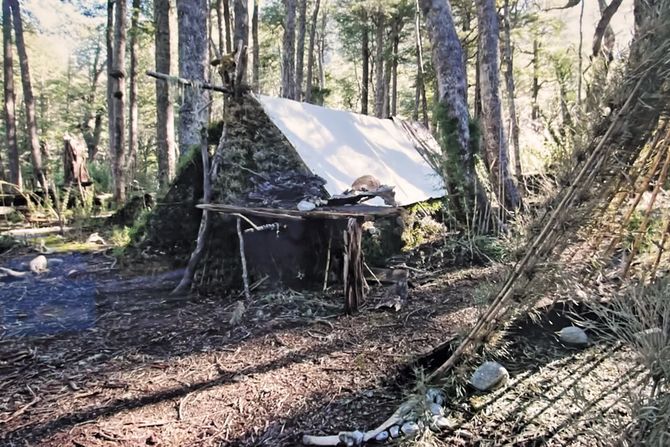
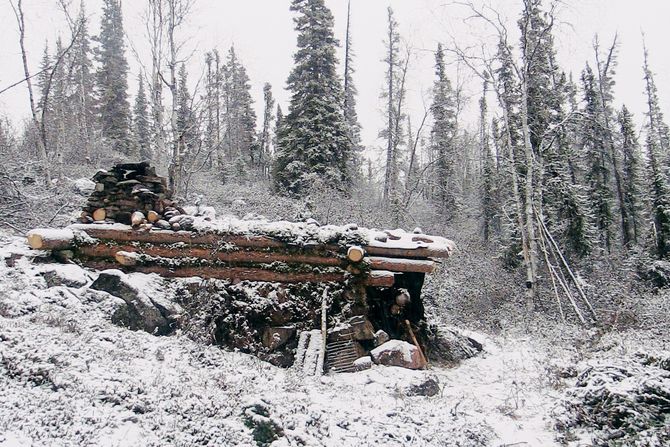
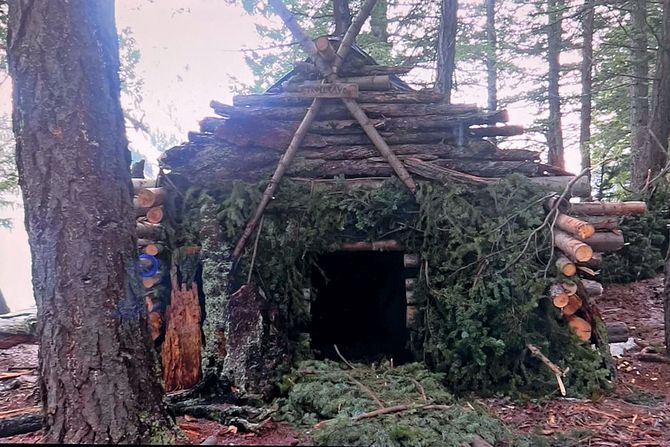
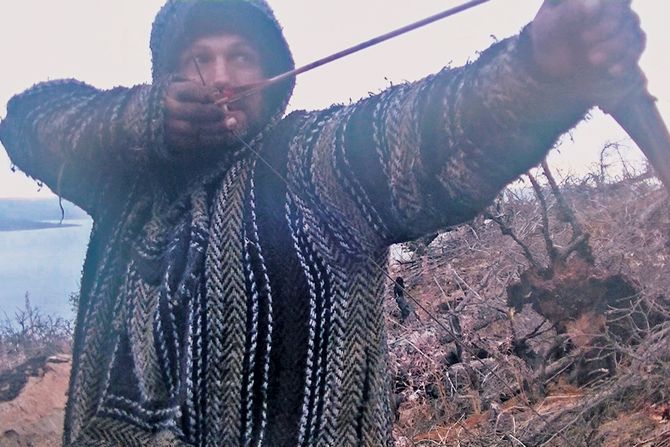
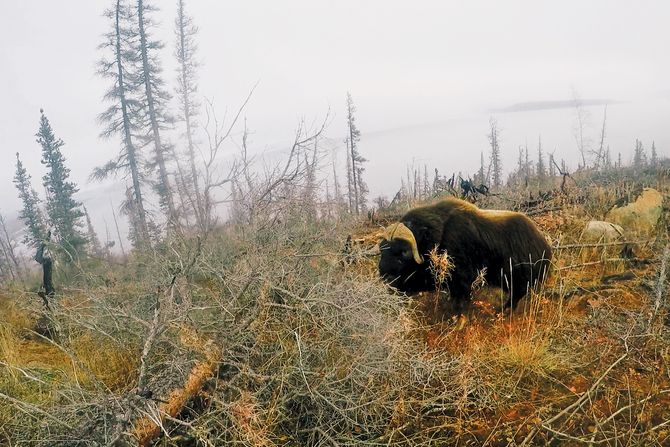
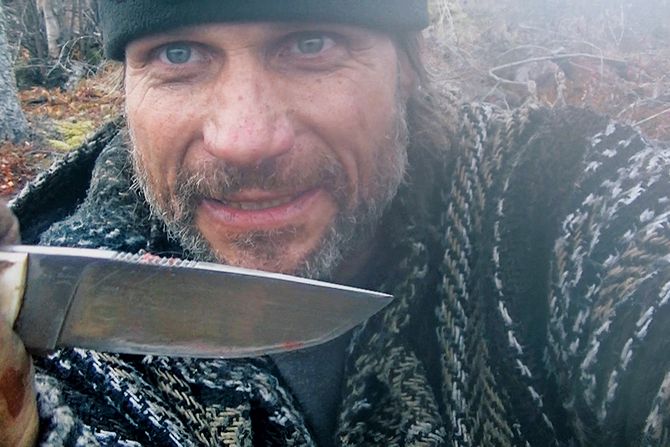
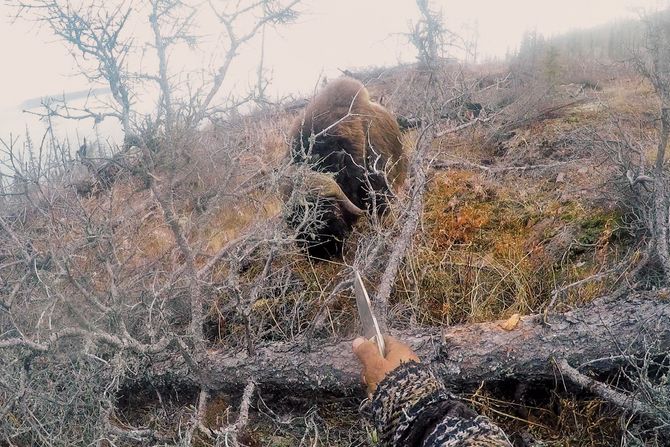
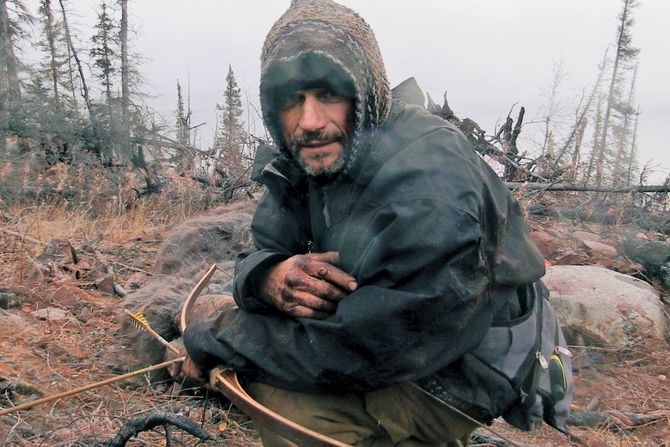
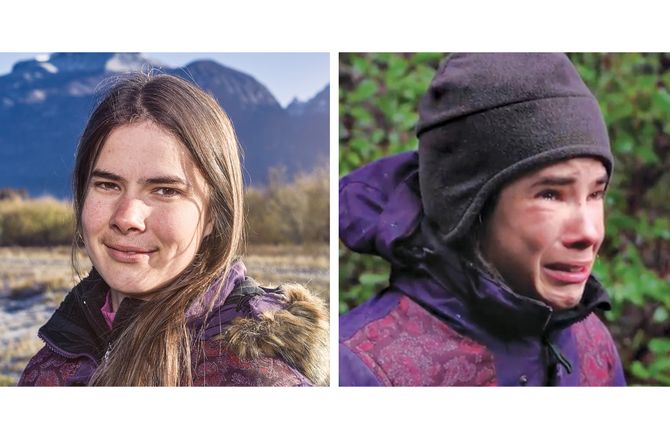
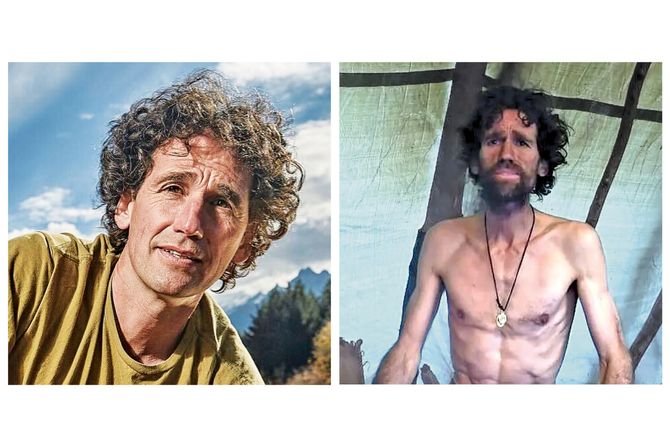
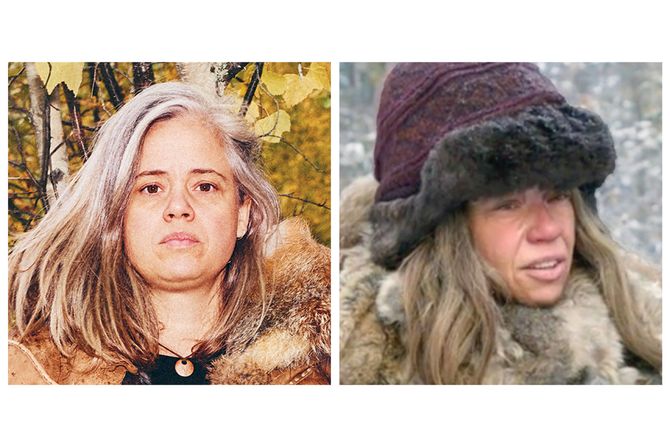
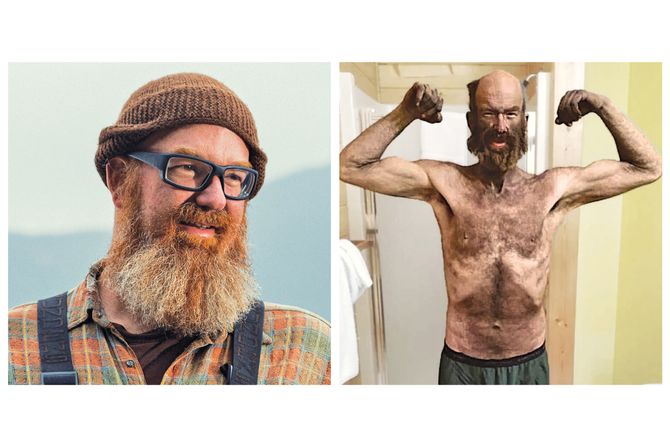














0 Response to "The Making of 'Alone,' the History Channel's Reality TV Show - Vulture"
Post a Comment